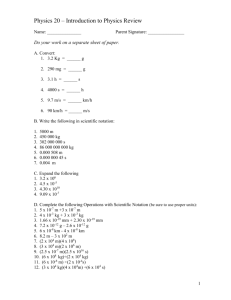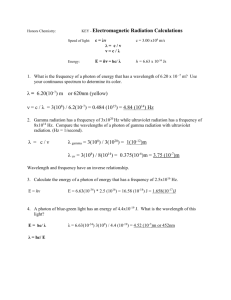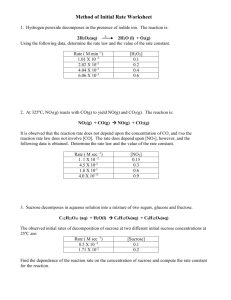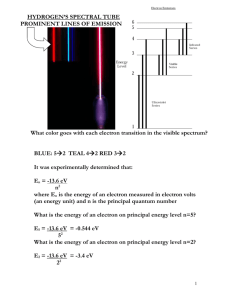Diffraction and Color Spectra
advertisement
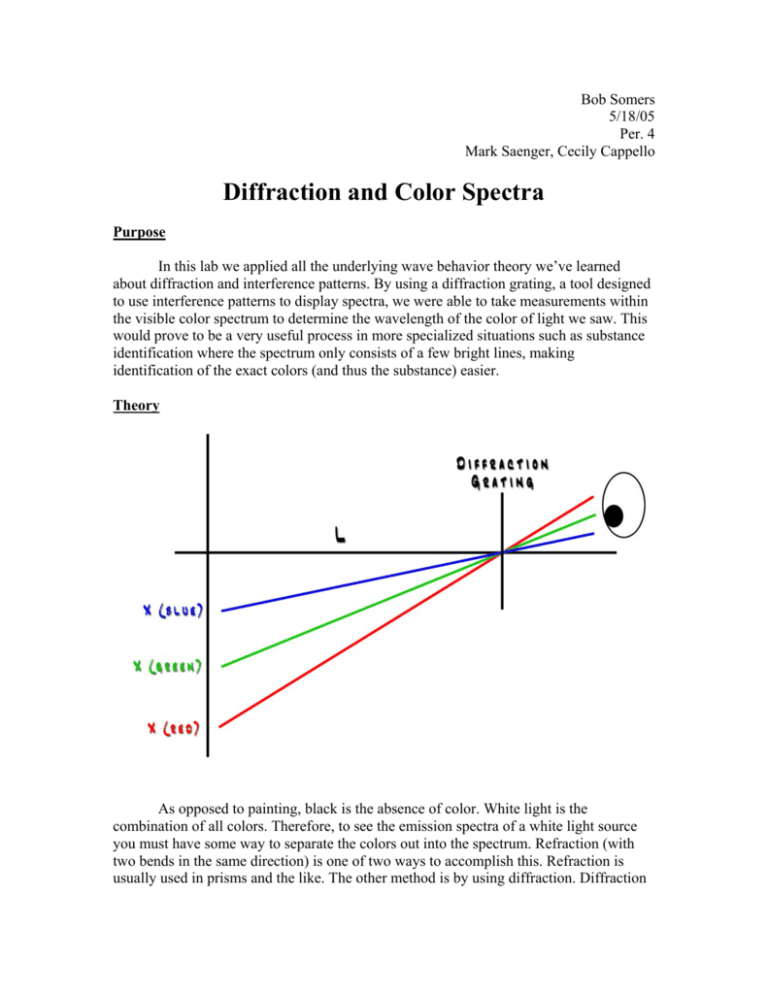
Bob Somers 5/18/05 Per. 4 Mark Saenger, Cecily Cappello Diffraction and Color Spectra Purpose In this lab we applied all the underlying wave behavior theory we’ve learned about diffraction and interference patterns. By using a diffraction grating, a tool designed to use interference patterns to display spectra, we were able to take measurements within the visible color spectrum to determine the wavelength of the color of light we saw. This would prove to be a very useful process in more specialized situations such as substance identification where the spectrum only consists of a few bright lines, making identification of the exact colors (and thus the substance) easier. Theory As opposed to painting, black is the absence of color. White light is the combination of all colors. Therefore, to see the emission spectra of a white light source you must have some way to separate the colors out into the spectrum. Refraction (with two bends in the same direction) is one of two ways to accomplish this. Refraction is usually used in prisms and the like. The other method is by using diffraction. Diffraction takes place as waves “bend” around corners, creating interference patters as the waves superimpose constructively and destructively. The points at which the waves superimpose perfectly constructively are called anti-nodes and end up being “bright spots” in the interference pattern. Oppositely, nodes are created where the waves superimpose perfectly destructively. These show up as “dark spots” on the interference pattern. The diffraction of perfectly white light yields an entire color spectrum. The spectrum seen when looking through a diffraction grating at a white light source is a virtual image, one that does not exist in the real world. This image is traced back by the eyes at a constant angle from the central line. The relationship of this angle to the wavelength of the wave and the distance between the slits of the diffraction grating (or any double-slit experiment for that matter) is defined as λ = d sin θ where λ is the wavelength of the wave, d is the distance between the slits, and θ is the constant angle from the order line to the central line. Because the angle stays constant, we can measure the components of this right triangle at any distance desirable and determine the angle with a simple tangent calculation. Carrying the angle through the above equation yields the wavelength of the wave. Procedure 1. Measure an L distance away from the lateral measurement device (usually a meter stick) and record this value. 2. Turn on the light source and place the diffraction grating distance L away from the lateral measurement device. Try to keep the grating in the same horizontal plane with the color spectrum. 3. Have a friend use a pointed object to locate the exact place on the lateral measurement device that a specific color appears. Record this value and repeat for each desired color. 4. Change the L distance and repeat steps 1 –3 for the new value. Data Trial 1 2 L 109.9 cm 69.9 cm X (red) 44.4 cm 27.4 cm X (green) 30.5 cm 19.7 cm Observations • The color spectrum is vertically “wavy”. • There are two black lines that pass horizontally through the spectrum. X (blue) 27.7 cm 18.3 cm • No matter how close or far away from the light source you are, the spectrum stays in the same place relative to the angle away from the light source. • The light source emits a very bright white light. • The diffraction grating looks “hazy”. • The range of reds appears wider than the range of greens and blues. • It was very difficult to align the diffraction grating on the same horizontal plane as the color spectrum. • The color spectrum was a virtual image. • A very, very faint second color spectrum can be seen further out horizontally about twice the distance of the first one to the light source. • The light source becomes very hot during operation. • Without sufficient shielding, the diffraction grating will catch color spectra from other light sources in the room. • The color spectrum appeared to the sides of the light source, not directly on top of it. Calculations Before we calculate the individual trials, we calculate the distance between each slit using the given value of the diffraction grating. 530 grooves x 1000 mm = 530,000 grooves/m mm 1m We then invert the fraction to attain the number of meters per one groove. = 2.0 x 10-6 1 530,000 Now we calculate the individual data for each trial and color. Trial 1 Using red’s measured values of XR = 44.4 cm and L = 109.9 cm and a simple tangent calculation we get the angle value of the first red order line. tan θ = 44.4 109.9 θ = 22.0° Next, using λ = d sin θ we can calculate the actual wavelength of the red wave using the distance between the grooves found above and our first red order line angle. λ = (2.0 x 10-6) sin 22.0° λ = 7.06 x 10-7 m Using green’s measured values of XG = 30.5 cm and L = 109.9 cm and a simple tangent calculation we get the angle value of the first green order line. tan θ = 30.5 109.9 θ = 15.5° Next, using λ = d sin θ we can calculate the actual wavelength of the green wave using the distance between the grooves found above and our first green order line angle. λ = (2.0 x 10-6) sin 15.5° λ = 5.05 x 10-7 m Using blue’s measured values of XB = 27.7 cm and L = 109.9 cm and a simple tangent calculation we get the angle value of the first blue order line. tan θ = 27.7 109.9 θ = 14.1° Next, using λ = d sin θ we can calculate the actual wavelength of the blue wave using the distance between the grooves found above and our first blue order line angle. λ = (2.0 x 10-6) sin 14.1° λ = 4.61 x 10-7 m Trial 2 Using red’s measured values of XR = 27.4 cm and L = 69.9 cm and a simple tangent calculation we get the angle value of the first red order line. tan θ = 27.4 69.9 θ = 21.4° Next, using λ = d sin θ we can calculate the actual wavelength of the red wave using the distance between the grooves found above and our first red order line angle. λ = (2.0 x 10-6) sin 21.4° λ = 6.89 x 10-7 m Using green’s measured values of XG = 19.7 cm and L = 69.9 cm and a simple tangent calculation we get the angle value of the first green order line. tan θ = 19.7 69.9 θ = 15.7° Next, using λ = d sin θ we can calculate the actual wavelength of the green wave using the distance between the grooves found above and our first green order line angle. λ = (2.0 x 10-6) sin 15.7° λ = 5.12 x 10-7 m Using blue’s measured values of XB = 18.3 cm and L = 69.9 cm and a simple tangent calculation we get the angle value of the first blue order line. tan θ = 18.3 69.9 θ = 14.7° Next, using λ = d sin θ we can calculate the actual wavelength of the blue wave using the distance between the grooves found above and our first blue order line angle. λ = (2.0 x 10-6) sin 14.7° λ = 4.78 x 10-7 m Averaging the red values gives us 7.06 x 10-7 – 6.89 x 10-7 = 6.98 x 10-7 m 2 Averaging the green values gives us 5.05 x 10-7 – 5.12 x 10-7 = 5.09 x 10-7 m 2 Averaging the blue values gives us 4.61 x 10-7 – 4.78 x 10-7 = 4.70 x 10-7 m 2 Finally, we compare these values to our accepted values of 6.90 x 10-7 m for red, 5.30 x 10-7 m for green, and 4.85 x 10-7 m for blue. Red Light 6.98 x 10-7 – 6.90 x 10-7 x 100 = 1.16 % error 6.90 x 10-7 Green Light 5.09 x 10-7 – 5.30 x 10-7 x 100 = -3.96 % error 5.30 x 10-7 Blue Light 4.70 x 10-7 – 4.85 x 10-7 x 100 = -3.09 % error 4.85 x 10-7 Error Analysis One source of error in the experiment is the fact that the color spectrum is somewhat wavy and not perfectly vertically straight. This is caused by the very thin filament that creates the white light. The filament doesn’t stand perfectly straight up, and thus bows in a wavy fashion, causing the spectrum to be slightly distorted. (On a separate note, this is what also causes the horizontal black strips through the spectrum. The black stripes are where the light from the filament is blocked by the rings that hold it in place.) This makes defining a location for a particular color difficult, because the color actually exists at a range of different places. Because this can both artificially shrink and enlarge the X value for a specific color, it can cause both a positive and negative error. Another source of error in the experiment is getting the diffraction grating aligned on the same plane as the color spectrum. This is extremely difficult to do precisely because the color spectrum is a virtual image. It isn’t exactly easy to align something real with something that doesn’t really exist. Our calculations assume that the spectrum and the grating were in the same plane with each other. Introducing a third dimension would add more complexity to the calculations, more distance than we allowed for, and thus a skewed, most likely negative error. We could calculate numbers smaller than were really true, carrying through both equations to produce a negative error. Conclusion In this lab, we were able to approximate the wavelengths of different colors of light with very high accuracy. We determined the value of “deep red” light to be 6.98 x 10-7, which is only 8 nanometers away from the accepted value 6.90 x 10-7. Forrest green was found to be 5.09 x 10-7 (accepted is 5.30 x 10-7) and royal “chair” blue was found to be 4.70 x 10-7 (accepted is 4.85-7). It is amazing to think that our experimental values were within nanometers of the accepted values. We are so accustomed to percentage points measured in millimeters, centimeters, or meters that the prefix nano- is quite alarming at first. However, when you closely examine the technique used to determine the wavelengths of color, the process is only prone to error on a very small scale, given that reasonable laboratory controls are used. In this lab, I would have never thought you could find the individual wavelengths of light so accurately so easily. The equipment involved is easy to use, inexpensive, and very effective at finding the correct answer. As we’ve been learning in class, we could even take this data one step further and find the frequency of the waves and their associated energies.
